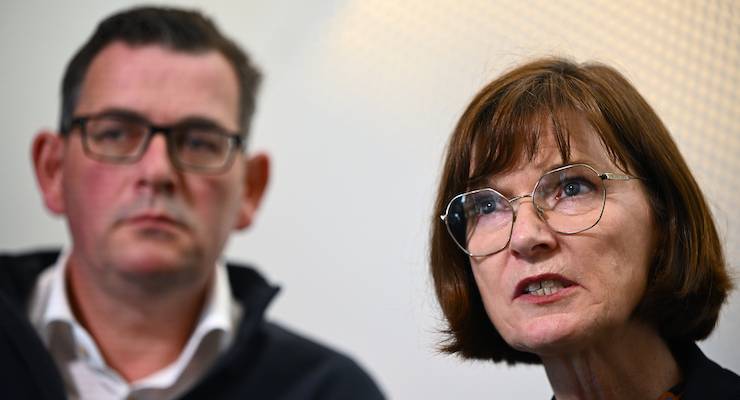
This is part three in an explainer series about the important issues in the Victorian election. Read part one here and part two here.
Few Victorians would be unaware their health system is, if not broken, then subsisting in a dangerously fragile state.
Since July last year the deaths of 33 people — toddlers and children among them — have been linked to the state’s triple-zero crisis, while chronic workforce shortages and extreme burnout within hospitals and across the primary health sector have periodically pushed emergency departments and ambulance services to the brink.
The cascading impact of these and related factors have elsewhere resulted in inordinately long waitlists for treatment, leaving countless people to languish without the physical or mental healthcare they require.
The Victorian government has, with some justification, blamed the pandemic for this upheaval, pointing to analogous problems in other states. The opposition, conversely, has repeatedly charged the government with “mismanagement and neglect” within this sphere. The truth, of course, is more nuanced than either side would have you believe.
Welcome to part three of Crikey’s explainer series on the Victorian election, which cuts through the noise of the major parties’ health bidding war to unpack the full significance of the issue as election day approaches.
The big picture
To begin with, the idea the state’s various and combined health crises primarily owe to the pandemic and the pandemic alone is, on any objective view, removed from reality. The unvarnished truth to many — including the Australian Medical Association — is that the Victorian health system has, by design, been underfunded by successive governments for decades. COVID-19 and the ensuing public health emergency merely exposed the inherent vulnerabilities created by a funding approach that privileges fiscal constraint over sustainability.
Figures published by the Productivity Commission in February this year revealed Victoria was spending considerably less money per person to run its public hospitals than any other state before the pandemic hit, with its equivalent of $2687 per capita recurrent funding in 2019-20 falling well short of the national average of $2971.
At its most basic, less funding means fewer nurses and fewer beds. It’s probably correct that the cost disparity was, in part, coloured by the geographically small and densely populated nature of the state (which lowers some of the cost) but that is not the full picture.
The government’s funding approach, rather, can be traced to the enduring ethos of small government championed under the Kennett premiership, when the state’s public hospital system was memorably savaged by funding cuts.
Some of that funding was restored when Kennett lost power, but his penchant for neoliberal public administration ultimately shifted political conventions in the long run. As a result, what was once a funding approach borne of ideology during the Kennett era in time became indistinguishable from the natural order of things.
The user-pays funding model underpinning the state’s Emergency Services Telecommunications Authority (ESTA) provides yet another case in point. Though the strain of COVID-19 waves certainly contributed to Victoria’s triple-zero crisis, the root of the problem lies in the ESTA’s funding model, recently described by Crikey’s political editor Bernard Keane as a “classic piece of neoliberal public administration policy”.
The impact of healthcare on the election campaign
Though Labor conventionally has an edge with respect to healthcare come any election, the rolling crises weathered by the health system in recent years have conspired to undermine this traditional advantage.
Sensing the Andrews government’s vulnerability, the opposition has engaged in a hospital bidding war with Labor, with the two major parties each pledging billions of dollars towards new hospitals or upgrades across the state.
The publicity surrounding the triple-zero crisis has also secured the ESTA considerable new funding, as Labor’s budget in May revealed, and both parties have flagged funds to reduce pressure on surgery waiting lists.
Meanwhile, the government has promised to fast-track the multi-billion-dollar investment into the mental health reforms recommended by the royal commission into mental health, and both parties have pledged funding to address workforce shortages.
On any view, the platforms of both parties are markedly ambitious. But questions of transparency have been aired along the way, with reports that many of the legion of funding promises announced by Labor are not, in fact, new, but were promised at the last election.
Related concerns have been levelled at the opposition’s plan to pay for its promises, which it loosely ties to the savings it says would flow from shelving Labor’s Suburban Rail Loop project.
More broadly, the politicised nature of the health bidding war has attracted concern, which some health bodies believe has eschewed a transparent, needs-based approach to funding and ultimately played chance with meaningful, structural reform.
Bottom line: Notwithstanding the multitude of problems witnessed across the health sector in recent years, it’s impossible to gauge whether health issues will sway voters on November 26, especially in light the twin corruption controversies that both parties have found themselves in recent weeks.
What is clear — if their promises are to be believed — is that the long shadow of Kennett-inspired spending approaches to health might finally be at an end.
Will Victoria’s health issues sway voters at the upcoming election? Let us know your thoughts by writing to letters@crikey.com.au. Please include your full name to be considered for publication. We reserve the right to edit for length and clarity.








Excellent article. I’ve seen nothing as objective, as comparable or as analytic in the mainstream media.
There’s one vitally important event concerning Victoria that few people will be aware of.
When Geof Kennet became premier, he detonated a nuclear bomb under Victoria’s Public Service (I was there and witnessed it first hand).
The biggest problem we’ve faced since is that incoming governments, no matter what their political persuasion, are anable to see or envisage what once was there and now is gone.
The result ? Any incoming government will not be able to see the destructive deficiencies that linger on until some crisis or other reveals some of them – and by then it may be too late to get fixes implemented in a timely fashion.
We’ve seen this play out ad nauseum with the pandemic. These kinds of fixed take time – particularly as they involve the recruitment of experienced and capable staff with often specialist skills (many of whom Kennet sacked).
So – we have some way to go here in Vic.
Was this the result of a night on the turps, https://www.smh.com.au/business/companies/unprofessional-behaviour-crikey-editor-in-chief-heckles-abc-journalists-during-walkleys-speech-20221118-p5bzd4.html
Read the article. Justified.
Such a passionate bunch!
The casemix system of funding is the best in the country. Most of the problem is social care, medics wages and overservicing.